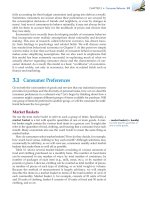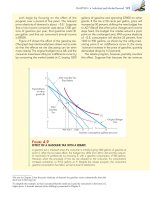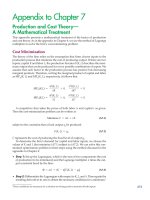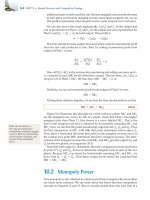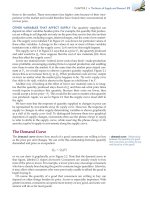(8th edition) (the pearson series in economics) robert pindyck, daniel rubinfeld microecon 112
Bạn đang xem bản rút gọn của tài liệu. Xem và tải ngay bản đầy đủ của tài liệu tại đây (98.42 KB, 1 trang )
CHAPTER 3 • Consumer Behavior 87
the problem is solved. Here, three indifference curves describe a consumer’s
preferences for food and clothing. Remember that of the three curves, the outermost curve, U3, yields the greatest amount of satisfaction, curve U2 the next
greatest amount, and curve U1 the least.
Note that point B on indifference curve U1 is not the most preferred choice,
because a reallocation of income in which more is spent on food and less on
clothing can increase the consumer’s satisfaction. In particular, by moving to
point A, the consumer spends the same amount of money and achieves the
increased level of satisfaction associated with indifference curve U2. In addition, note that baskets located to the right and above indifference curve U2, like
the basket associated with D on indifference curve U3, achieve a higher level of
satisfaction but cannot be purchased with the available income. Therefore, A
maximizes the consumer’s satisfaction.
We see from this analysis that the basket which maximizes satisfaction must lie
on the highest indifference curve that touches the budget line. Point A is the point
of tangency between indifference curve U2 and the budget line. At A, the slope of
the budget line is exactly equal to the slope of the indifference curve. Because the
MRS (−⌬C/⌬F) is the negative of the slope of the indifference curve, we can say
that satisfaction is maximized (given the budget constraint) at the point where
MRS = PF/PC
(3.3)
This is an important result: Satisfaction is maximized when the marginal rate of
substitution (of F for C) is equal to the ratio of the prices (of F to C). Thus the consumer can obtain maximum satisfaction by adjusting his consumption of goods
F and C so that the MRS equals the price ratio.
The condition given in equation (3.3) illustrates the kinds of optimization
conditions that arise in economics. In this instance, satisfaction is maximized
when the marginal benefit—the benefit associated with the consumption of one
additional unit of food—is equal to the marginal cost—the cost of the additional
unit of food. The marginal benefit is measured by the MRS. At point A, it equals
1/2 (the magnitude of the slope of the indifference curve), which implies that
the consumer is willing to give up 1/2 unit of clothing to obtain 1 unit of food.
At the same point, the marginal cost is measured by the magnitude of the slope
of the budget line; it too equals 1/2 because the cost of getting one unit of food is
giving up 1/2 unit of clothing (PF ϭ 1 and PC ϭ 2 on the budget line).
If the MRS is less or greater than the price ratio, the consumer’s satisfaction
has not been maximized. For example, compare point B in Figure 3.13 to point A.
At point B, the consumer is purchasing 20 units of food and 30 units of clothing.
The price ratio (or marginal cost) is equal to 1/2 because food costs $1 and clothing $2. However, the MRS (or marginal benefit) is greater than 1/2; it is approximately 1. As a result, the consumer is able to substitute 1 unit of food for 1 unit
of clothing without loss of satisfaction. Because food is cheaper than clothing, it
is in her interest to buy more food and less clothing. If our consumer purchases
1 less unit of clothing, for example, the $2 saved can be allocated to two units of
food, even though only one unit is needed to maintain her level of satisfaction.
The reallocation of the budget continues in this manner (moving along the
budget line), until we reach point A, where the price ratio of 1/2 just equals the
MRS of 1/2. This point implies that our consumer is willing to trade one unit
of clothing for two units of food. Only when the condition MRS ϭ 1/2 ϭ PF/PC
holds is she maximizing her satisfaction.
The result that the MRS equals the price ratio is deceptively powerful.
Imagine two consumers who have just purchased various quantities of food and
• marginal benefit Benefit
from the consumption of one
additional unit of a good.
• marginal cost Cost of one
additional unit of a good.

